When it comes to enhancing the curb appeal of your home, landscaping may be the first thing that comes to mind. But have you heard of hardscaping? Incorporating hardscape features like retaining walls into your outdoor design can transform your property into a stunning and functional space.
Retaining walls are an essential component of hardscaping projects, providing both aesthetic and practical benefits. They can help prevent soil erosion, level out uneven terrain, and define different sections of your yard.
If you’re considering a hardscaping project, look no further than retaining walls to add value, functionality, and beauty to your outdoor space.
Key Takeaways:
- Hardscaping projects can enhance the curb appeal of your home.
- Retaining walls are an essential feature of hardscaping, providing practical and aesthetic benefits.
- Retaining walls can help prevent soil erosion, level out uneven terrain, and define different sections of your yard.
What are Retaining Walls?
If you’re looking to improve your home’s curb appeal with hardscaping, retaining walls can be a key element of your project. But what exactly are retaining walls? Essentially, they are structures designed to hold back soil and prevent erosion. They are commonly used in landscaping to create level terraces on sloped properties or to stabilize soil surrounding garden beds or structures.
Retaining walls come in a variety of materials, including concrete, bricks, and natural stone. Each material has its advantages and disadvantages, depending on the specific project and desired aesthetic. Concrete retaining walls are durable and low-maintenance, while natural stone walls offer a more rustic and organic look. Bricks are often used for a classic, timeless appearance.
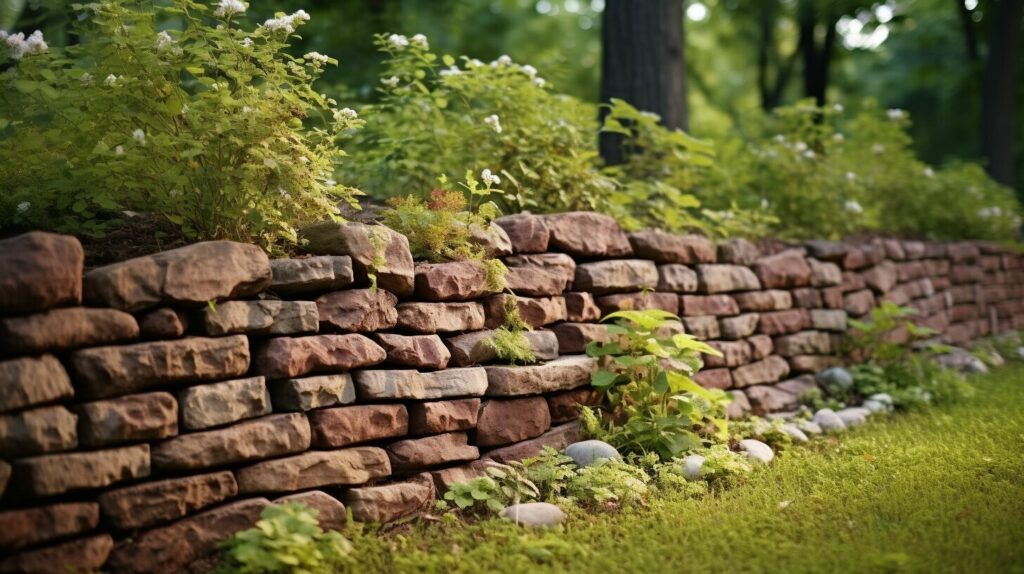
No matter the material, retaining walls are an essential piece of hardscaping that can create a stunning and functional design in your outdoor space.
Enhancing Curb Appeal with Retaining Walls
If you’re looking for a way to give your home’s outdoor space an impressive facelift, look no further than retaining walls. These hardscaping features are a perfect addition to your yard, not only for their practical function but also for their aesthetic appeal. Retaining walls can easily transform your yard from drab to fab, making it the envy of the neighborhood!
When it comes to enhancing your home’s curb appeal, retaining walls can play a significant role. With their unique design and aesthetic appeal, retaining walls can add character and visual interest to your outdoor space. Whether you want to create a terraced garden, define outdoor living spaces, or add a retaining wall to your front yard, there are many design options available to help you achieve your desired look.
One way to enhance the look of your retaining walls is to incorporate unique features such as waterfalls, rock gardens, or built-in flowerbeds. These added features bring an extra touch of personality and style to your retaining wall and can help it stand out from other hardscaping elements in your yard.
Another way to enhance the appeal of your retaining walls is to experiment with different materials. Retaining walls can be made from a variety of materials, including concrete, brick, natural stone, and wood. Each material has its unique texture, color, and design potential, allowing you to create a wall that compliments your home’s architectural style and outdoor aesthetic.
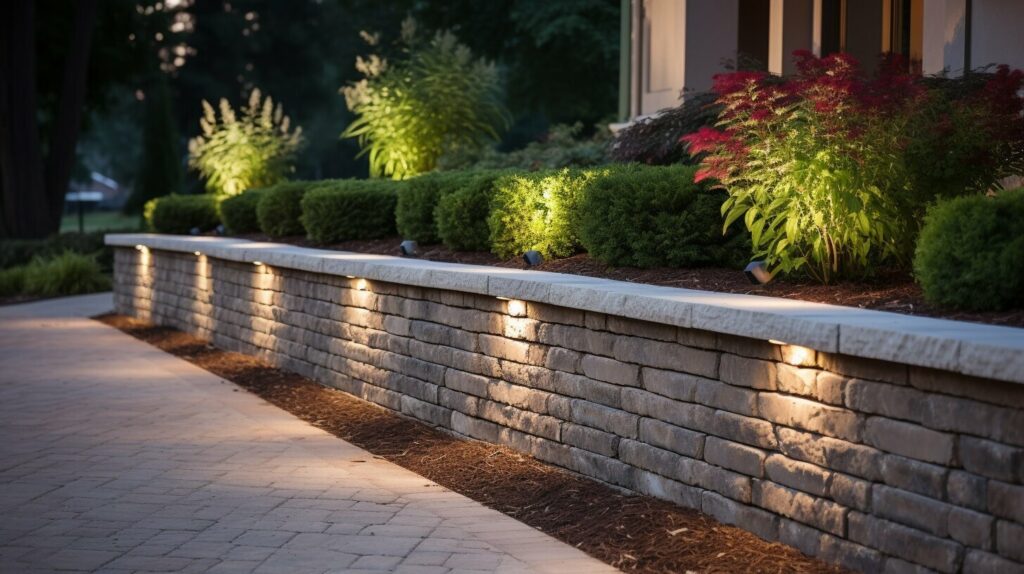
Incorporating retaining walls into your hardscaping projects can significantly boost your home’s curb appeal and property value. Not only do these structures add visual interest and character to your outdoor space, but they can also help mitigate soil erosion and drainage issues. Plus, retaining walls provide the perfect opportunity to create functional spaces like seating areas, stairs, and planters.
Whether you’re looking to create a dramatic outdoor living space or simply add more structure to your yard, retaining walls are an excellent choice. They’re affordable, versatile, and can be customized to fit your unique needs and style preferences. By adding a retaining wall to your home’s outdoor space, you can create a stunning and functional focal point that will impress visitors for years to come!
Creating Functional Spaces with Retaining Walls
Retaining walls are not only visually appealing but also serve a practical purpose in hardscaping projects. By creating different levels in your yard, retaining walls can be used to create functional spaces such as seating areas or different zones for specific activities.
If you have a sloped yard, retaining walls can be used to level out different areas, allowing for a more accessible and functional space. You can also create terraced gardens to show off your favorite plants and greenery. Retaining walls can also be used to define specific zones for activities such as outdoor games or cooking and dining areas.
But before you start building, it’s important to consider the design and materials used for your retaining walls. You want to make sure that the retaining walls blend seamlessly with your overall landscape and hardscape design. Some popular materials used for retaining walls include natural stone, concrete blocks, and bricks.
When designing your retaining walls, consider incorporating built-in seating or other unique features that will add both form and function to your hardscaping project. And don’t forget to keep water drainage in mind to prevent any potential water damage or erosion.
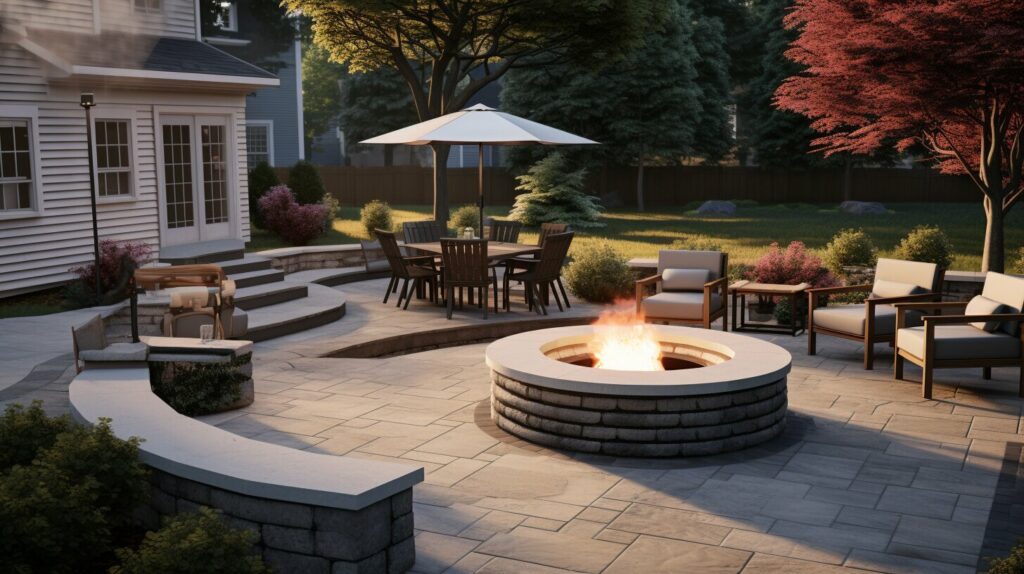
“Retaining walls can transform your sloped yard into a multi-level outdoor living space that is both functional and visually stunning.”
Walkways and Pathways: Aesthetic and Practical Solutions
Walkways and pathways are crucial components of hardscaping projects. They serve both aesthetic and practical purposes, enhancing the overall appearance of your outdoor space while providing safe and convenient access to different areas.
When designing your walkways and pathways, consider the style and theme of your home and outdoor space. Natural stone or brick pavers can provide a classic and elegant look, while stamped concrete or colored gravel can add a modern and contemporary feel. You can also mix and match materials to create unique patterns and designs.
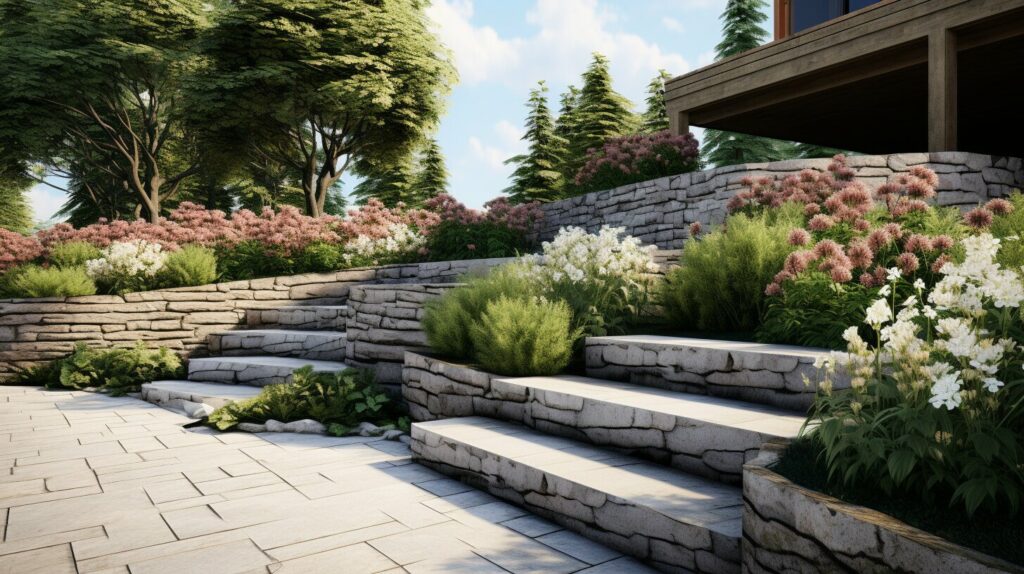
Aside from aesthetics, also consider the functionality of your walkways and pathways. They should lead to key areas such as the front door, driveway, patio, or garden, and be wide enough for easy passage. If you have children or elderly family members, make sure they are slip-resistant and easy to navigate.
Don’t be afraid to add accents to your walkways and pathways. Lighting fixtures, such as low-voltage LED lights, can not only provide a warm and inviting atmosphere but also increase safety at night. Planters or border edging can add a touch of greenery and define your walkways and pathways.
Remember that your walkways and pathways are an extension of your overall hardscaping design, and should complement and enhance the other features such as retaining walls and patios. By considering both practicality and aesthetics, your walkways and pathways can elevate the beauty and functionality of your outdoor space.
Transforming Outdoor Spaces with Patios
If you’re looking to take your outdoor space to the next level, a patio is an excellent addition to any hardscaping project. Patios provide the perfect place for outdoor dining, relaxing, and entertaining guests.
When considering a patio for your outdoor space, there are a few things to keep in mind. First, decide on the material you want to use. Concrete is a popular option for its durability and versatility, but there are many other materials to choose from, including pavers, natural stone, and brick.
Tip: Consider the style of your home and outdoor space when choosing a patio material. You want to make sure the patio complements the overall aesthetic of your property.
Once you’ve chosen your material, think about the design of your patio. Do you want a simple, rectangular patio or something more elaborate with curves and patterns? The possibilities are endless.
Tip: Incorporate seating walls or an outdoor fireplace to create a cozy atmosphere and make your patio the perfect place to gather with friends and family.
Finally, don’t forget to add some finishing touches to your patio. Outdoor lighting, plants, and outdoor furniture can all help to create a warm and inviting atmosphere.
Tip: Consider adding a pergola or awning to your patio to provide shade and protection from the elements.
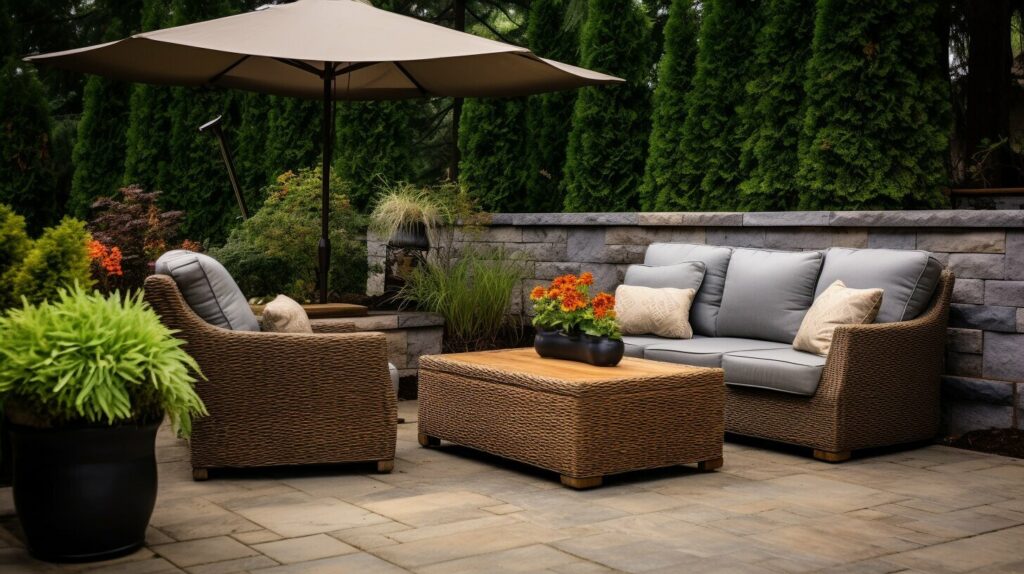
With the right materials, design, and finishing touches, a patio can transform your outdoor space into a beautiful and functional area that you’ll enjoy for years to come.
Adding Personality with Hardscape Accents
When it comes to hardscaping, adding accents can take your outdoor space to the next level. Whether you’re looking for a dramatic focal point or a subtle touch of elegance, hardscape accents can enhance the aesthetics and functionality of your design.
One popular accent is the fire pit. Not only does it add warmth and ambiance to your outdoor area, but it also serves as a perfect gathering place for family and friends. You can choose from different materials such as concrete, stone, or metal, and customize the size and shape to fit your space. Adding a fire pit to your hardscaping project can increase the value and appeal of your home.
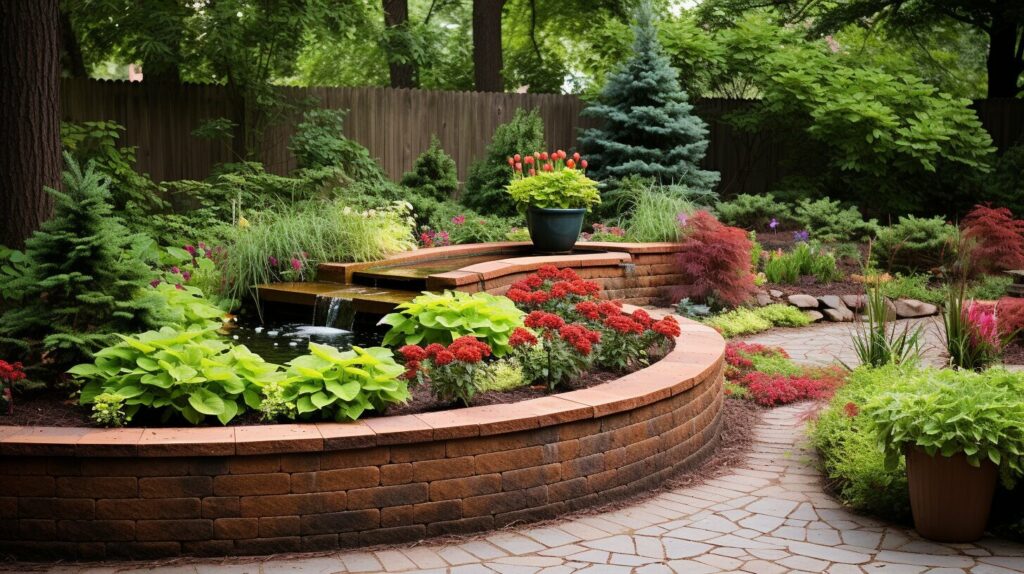
Water features are another great way to add personality to your outdoor space. You can choose from fountains, cascades, or ponds, depending on your preference and budget. Water features offer both aesthetic and practical benefits, such as reducing noise pollution and providing a calming environment.
Lighting is also an essential accent that can highlight your hardscaping design and create a cozy ambiance. You can choose from different types of lighting such as path lights, spotlights, or string lights, depending on your style and needs. Lighting can also improve safety and security by illuminating dark corners.
Pro Tip: Incorporating hardscape accents can turn your outdoor space from ordinary to extraordinary. Consult with a hardscaping professional to discuss different accent options and create a design that complements your lifestyle.
Maintaining and Protecting Your Hardscaping Investment
Once you have your hardscaping project completed, you want to make sure it stays looking great for years to come. Regular maintenance is key to preserving the longevity and appearance of your hardscaping features.
One of the most important things you can do is to keep your retaining walls and walkways clean. Regularly sweeping or using a leaf blower to clear away debris can prevent buildup that can be difficult to remove later.
Another important step is to inspect your hardscaping features for any damage. Check for cracks, loose stones or bricks, or signs of erosion. Taking care of any issues as soon as they arise can prevent more extensive damage and costly repairs.
Protecting your hardscaping investment also means being mindful of potential hazards. Be careful when using shovels or other tools around retaining walls to avoid accidentally damaging them. Additionally, be mindful of the placement of sprinklers and make sure they are not causing erosion or excess water buildup that can damage your hardscaping features.
Overall, regular maintenance and careful use are key to protecting your hardscaping investment. By taking these steps, you can ensure the longevity and beauty of your outdoor space for years to come.
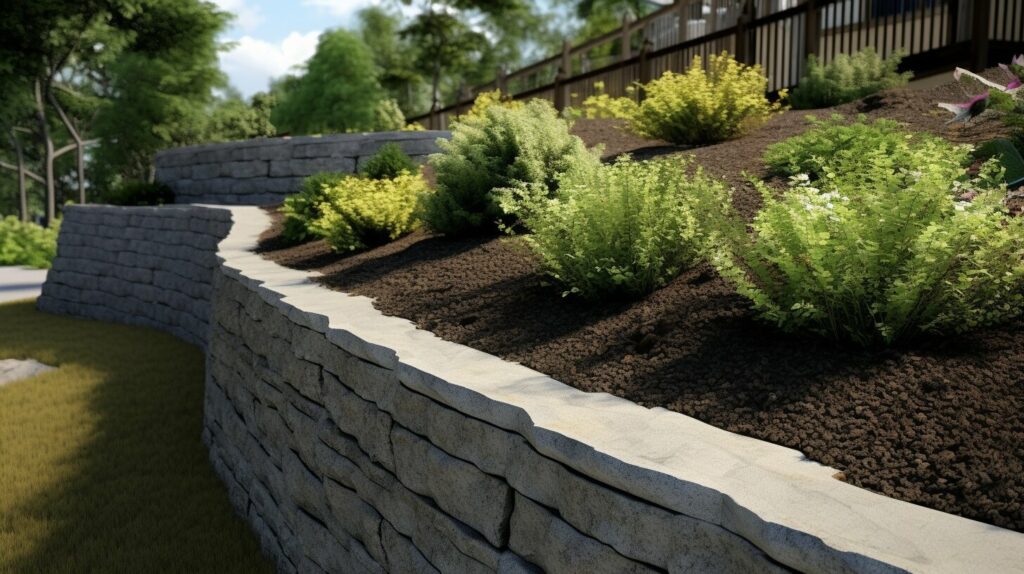
Hiring Professionals for Hardscaping Projects
If you want to ensure a successful and visually appealing outcome for your hardscaping project, consider hiring a professional who specializes in this area. Professionals have the expertise, experience, and creativity needed to transform your outdoor space into a beautiful and functional area that increases the value of your home.
When hiring a professional, it’s important to consider their qualifications, experience, and portfolio of work. Look for professionals who are licensed, insured, and have a solid reputation in the industry. You can also ask for references from previous clients to get an idea of their work quality and level of customer service.
Working with a professional also offers other benefits. They can help you navigate the permit process, ensure that your project is up to code, and provide a detailed timeline and budget for the project. They also have access to a wide range of materials and equipment that may not be readily available to homeowners.
Overall, hiring a professional for your hardscaping project can save you time, money, and stress in the long run. They bring a level of professionalism and expertise that can turn your outdoor space into a beautiful and functional area that will provide years of enjoyment and add value to your home.
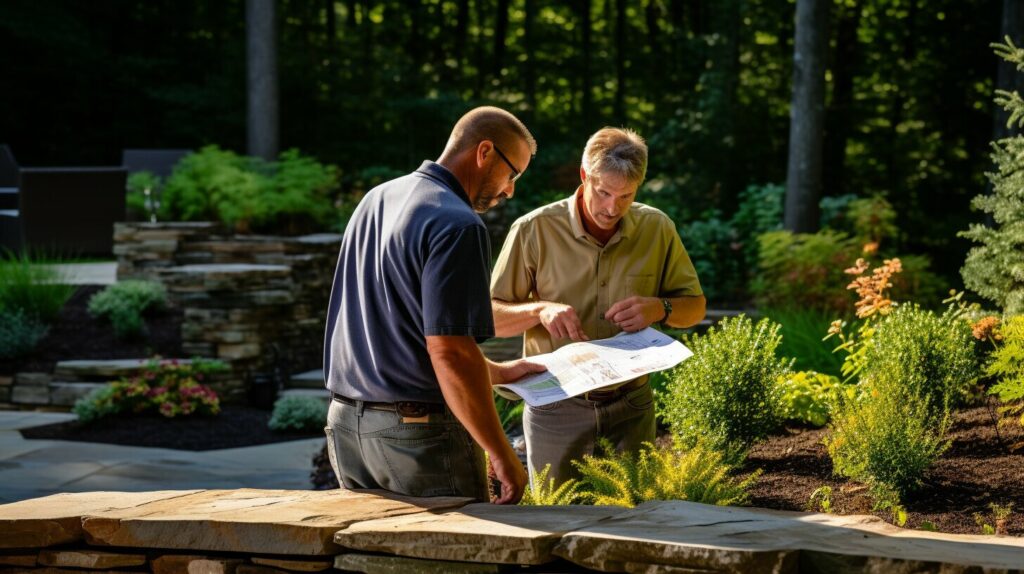
Conclusion: Transform Your Outdoor Space with Hardscaping
By incorporating hardscaping into your outdoor design, you can significantly boost your home’s curb appeal and increase its value. Retaining walls, walkways, patios, and hardscape accents are just a few of the many options you have to transform your outdoor space into a beautiful and functional area.
Remember to maintain and protect your hardscaping investment to ensure its longevity and appeal. Regular maintenance routines and prevention techniques can keep your hardscape features looking brand new for years to come.
While hardscaping can be a DIY project, hiring a professional can provide you with the expertise, experience, and creativity needed for a successful and visually appealing outcome. So, whether you decide to tackle the project yourself or hire a professional, get started on transforming your outdoor space with hardscaping today!
FAQ
Q: What is hardscaping?
A: Hardscaping refers to the use of hard materials and structures, such as retaining walls, walkways, and patios, to enhance the functionality and aesthetics of outdoor spaces.
Q: How do retaining walls contribute to curb appeal?
A: Retaining walls can greatly enhance curb appeal by adding visual interest, creating terraced gardens, providing a level surface for seating areas, and preventing soil erosion.
Q: What materials are commonly used for retaining walls?
A: Common materials used for retaining walls include concrete, natural stone, brick, and timber. Each material has its own unique look and benefits.
Q: What design options are available for retaining walls?
A: Retaining walls can be designed in various styles, such as straight or curved, and can incorporate decorative elements like planters, lighting, and seating areas.
Q: How can retaining walls create functional spaces?
A: Retaining walls can be used to level uneven terrains, create seating areas, define different zones in your yard, and provide structural support for outdoor features.
Q: What are some popular materials for walkways and pathways?
A: Popular materials for walkways and pathways include pavers, flagstone, gravel, and concrete. These materials offer a range of styles and durability options.
Q: How can patios enhance outdoor spaces?
A: Patios provide a dedicated area for outdoor living, dining, and entertaining. They can be designed in various shapes and sizes and can be constructed using materials like concrete, pavers, or natural stone.
Q: What are hardscape accents?
A: Hardscape accents are decorative elements that add personality and charm to hardscaping projects. Examples include fire pits, water features, outdoor lighting, and decorative planters.
Q: How can I maintain and protect my hardscape investment?
A: Regular maintenance, such as cleaning, sealing, and inspecting for damage, is crucial for preserving the beauty and longevity of your hardscaping features. It’s also important to address any issues promptly and take preventive measures.
Q: Why should I hire professionals for hardscaping projects?
A: Hiring professionals ensures that your hardscaping project is executed with expertise, creativity, and attention to detail. Professionals have the knowledge and experience to handle complex designs and can save you time and effort.
